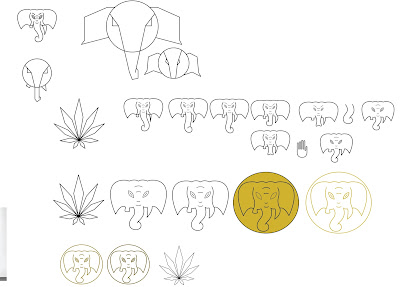To continue developing the project, a series of different ideas were used for the starting point of the brand campaign. This meant looking at Indian symbolism, religious beliefs and tradition. This would then inspire the designs to reflect a traditional Indian aesthetic. One thing to keep in mind while working on this, would be to consider how it can be placed within the same market as other attractive skin care brands and how it will appeal to the intended audience.
As the target audience is 65 and over, it was found that skin care products were likely to attract many people in this category, especially if the products were stylish or high end. Therefore, by looking at high end skin products, there would be more inspiration on ways to make the brand appealing.
Looking at traditional face paint used in Indian tradition was one way to gather ideas for a logo design. From this, it was possible to find where the face painting culture originates. In Hinduism, face painting can be found on depictions of different gods, including Krishna and Ganesh.
Several initial sketches were made of the Hindu gods, as they were recognisable symbols of the faith and could interpreted by the audience as having a link to Indian culture.
Drawing the face of an elephant would be inspired by the Hindu god, Ganesh. It was decided at this point that it would be the most recognisable option to choose. The minimal approach to the design was inspired by the minimal patterns used in Indian face painting. At a later stage more detail could be added.
Developing these sketches would bring about a logo design to associate the brand with. The cannabis leaf was also designed with the packaging in mind. As the brand would need to be explanatory of its relation to the drug, showing the leaf would make it more clear to the audience.
In the same way that the Ganesh design was developed, the cannabis leaf was used as a way to look at pattern design. Here the leaf had been placed within a circle and copied over and over, using different sizes.

To make sure that the audience was aware of the Hindu god, a pair of hands were added to the design, showing that the god has human features and well as animal features. These hand designs were also inspired by many styles found within Indian culture.
Choosing a colour scheme meant thinking of how the patterns would look when applied to the packaging, as well as how they would relate to the context. In this case, cannabis is mostly associated with the colour green. Therefore different shades were tested on the logo.
Many Hindus also celebrate in Diwali, which centres around the idea of 'light over darkness'. Therefore, bright colours are associated with the festival, including gold in most cases.

When applying the gold to the logo, it seemed to be the best option as the packaging was likely to be white, making it a stand out colour that would also allow the brand to look authentic.
The logo had also began to finalise at this stage, with zigzag patterns being applied around the border and in small spaces within. The final step from here would be to find appropriate typeface to match.

When deciding on a typeface to use, several different variations were first collected and analysed for their features. Having looked at high end brands such as L'Occitane, it was clear that in order to make the brand suitable for the high end market, a serif font such as Garamond Pro or Minion Pro would be the best option.

Other fonts that were looked at include Samarkan, ArivNdr POMt, Sefer AH and Alcazar Regular. These were all found to be fonts that would communicate the culture more blatantly, through recognisable Indian styles and Hindu interpretation of the brand name, Lifted Spirit.
Applying these fonts to the logo in different ways would allow for further feedback at the final stages of the project. Personally, the designs that were considered best would be the ones either using the Samarkan font or the Alcazar font.

While Alcazar was more legible as it possessed more weight in the letters, the Samarkan font made the logo more suited to the recognisable Indian aesthetic. This is probably because the style of Samarkan can be recognised by almost all audiences, as a popular style among Indian design.
Some of the fonts that were not used at this stage may be considered for later stages, such as website proposals.
When consulting peers about which logo to use, the most popular was the Samarkan font logo. This was because it best represented the Indian traditional style. It was also suggested that the text remain below the logo, as it was easier to read when both words were side by side.
When analysing the finalised logo, it has been proven that the Samarkan font worked best under the logo. The use of gold has also allowed the design to place itself within a high end market, appealing the the same audiences as competitors. The next step in the project would be to apply the design to context, including mock up and proposals. This way further exploration can be made as to how design can be used to communicate to the intended audience.






































